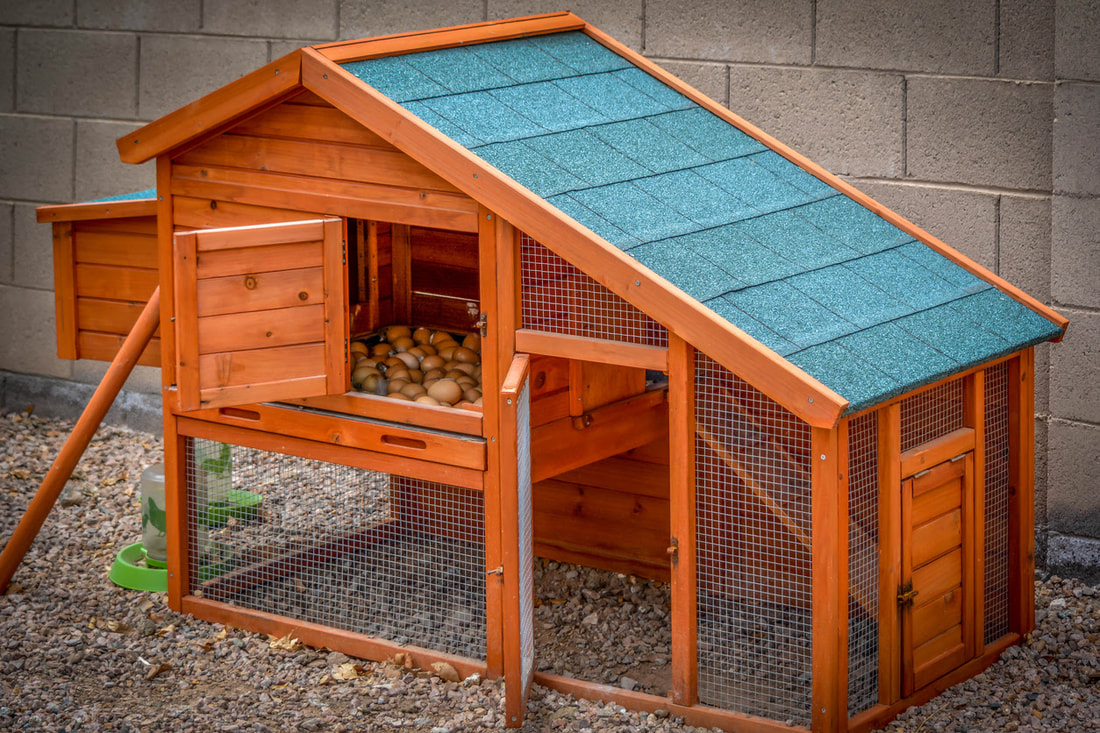|
In recent years it has become increasingly popular to have your very own backyard chickens. What better way to buy local, right?! If you happen to be considering starting your own venture into chicken husbandry you'll need to think about housing your chickens and building the best coop for your new clucky friends. We'll talk about size, ventilation, insulation, construction materials, nesting boxes, and all things building your birds their best home. 1. Make it Legal Before you start mapping out your yard and deciding on placement for your chicken coop, make sure you visit the appropriate local authorities. You'll need to find the laws your state and city have for backyard chicken husbandry before you begin. Some locations have limitations on the number of birds an individual can own and may forbid homeowners to keep backyard fowl period. If your neighborhood has a Home Owner's Association you might want to check in with them as well. While we here at PopWorms! thoroughly enjoy chickens and the benefits of owning them, not everyone feels this way. 2. Location According to Claborn Farms there are a few important factors to consider when choosing placement for your chicken coop. The first factor is convenience. Where you place your coop should be easily accessible while still being safe for your chickens. You'll want your coop to be located someplace you're able to easily collect eggs, feed, water, and care for your chickens. The second is shade. If you live in a warmer climate placing your coop in the shade of a large tree, or providing shade another way, will be important for keeping your chickens cool during the hot summer months. Your coop should also be located in an area with good drainage and dry ground for sanitary and health reasons. Finally, you'll want to place your chickens where it most benefits your yard. For farm owners, having chickens is highly beneficial as they can move them around to where they're needed to fertilize orchards, gardens (in the off season) and lawns. Since your coop will likely not be portable, it's important to place it where it works best for you and your chickens. 3. Building Materials First and foremost, you'll need some building plans for your coop. You can purchase chicken coop plans, or there are websites like The Happy Chicken who offer free DIY chicken coop plans. If you're feeling daring you also have the option to create your own. Once you have your plans you'll need to start gathering materials. Depending on your design you have a few options for building materials. Generally speaking, you'll need materials for framing, walls, ramps, foundation, doors, windows (if you want them), roofing, exterior finishes, and fencing or screens. Your choice in materials will vary according to your chicken coop plans. What works for someone else's coop may not also work for yours. Coop Design Plans has multiple suggestions for creative material use in chicken coops. They are quick to point out that while lumber works best and allows more creativity in construction, it can often be more expensive. If it is within your budget, it's a great option. Coop Design Plans also states that fencing your chickens in for their chicken run will need to be done with careful consideration. While chicken wire might seem like the most obvious choice, it rusts quickly and doesn't protect your chickens from predators. Chain link fencing poses a similar problem as smaller predators, like raccoons, can still get their hands through the fence. Creating a wood framed and screened chicken run that's attached to your chicken coop may be preferable in this instance. You have endless options for the roofing of your coop as it's acceptable to use just about anything you'd use for roofing on a house. This opens up a lot of options for design, aesthetic, and overall safety. 4. Size The size of your chicken coop will depend on how many chickens you intend/are allowed to have. It's important not to build for more chickens than you have the space for. You'll also have to be within the limitations set by your city and state. The general concesus is that you need 2-3 square feet per chicken inside the coop and roughly 8-10 square feet per chicken in an outside run. Make sure you have the space for these accommodations prior to building. 5. Ventilation and Insulation According to Better Hens and Gardens ventilation is of the utmost importance for chicken health, even in winter. You might be thinking, "But won't my chickens be cold? It's freezing outside!" Truth be told, chickens generate a lot of heat all by themselves! During the winter months your chickens may be spending more and more time inside the coop. Their body heat, breathing, and droppings all create moisture and humidity inside the coop. That moisture in the air can create a multitude of problems for your feathery friends including illness, frostbite, and respiratory tract damage. The amount of ventilation required will depend upon the climate and weather conditions. The hotter it gets, the more ventilation your chickens will need. In places where very hot weather isn't a concern the recommendation is one square foot of ventilation per ten square feet of floor space. Insulating your chicken coop is easy. Simply make sure to fill in any holes in the walls. Additionally, you'll want to check for any drafts in the coop. If you do find it to be a bit drafty you can use caulking to cover any gaps or cracks in the coop. 6. Nesting Boxes The folks over at The Happy Chicken Coop make a great point: the nesting boxes are not for the chickens, they are for YOU! Chickens will lay their eggs wherever they feel safe and secure. The nesting boxes make it so you can easily find and collect eggs each day. Otherwise you would be searching the whole area for eggs. The ideal nesting box is quiet, safe, private, and dark. It should be in a low activity area and no more than 18 inches off the ground. The number of boxes you need will depend upon the number of hens you have and size will depend on the breed you have chosen. You have the option of building your nesting box into your coop, purchasing one, or creating one of your own. The nesting boxes create a safe place for egg laying while maintaining convenience for you, it's a win-win! Deciding to get backyard chickens is a huge decision. It requires a lot of careful thought and planning. We hope this guide gives you a jumpstart in your planning so you can make your way towards creating the dream chicken coop for both you and your charming fowl. Already have a coop or want to get stocked up on PopWorms! for your incoming flock? Use the code COOP for 20% off PopWorms! ECO 1 lb and PopWorms! Live, good until 3/15/2019!
22 Comments
Jeff
4/26/2020 02:21:46 pm
I have 6 week old chickens (4) my 1st go at this
Reply
7/1/2020 09:40:07 pm
Great advice we just built our girls a new coop i really think they love it.
Reply
9/3/2020 03:11:15 am
This is really appreciated that you have presented all data on building your own chicken coop.I love all the information shared. I like how you have researched and presented these exact points so clearly. Great article! When you look for same type of great content, like here then check out this http://www.proroofing.co.nz/ also.
Reply
1/5/2021 10:44:56 pm
Thanks to the author for sharing such a great post. The article was very well written and providing great info about building your own chicken coop . It can be really great for people like me who are looking for grabbing more knowledge about it. You must also check outhttp://www.insulationservices.co.nz it has some great insights too.
Reply
1/16/2021 03:53:50 am
From this article you will get to know insightful information regarding building your own chicken coop. I loved reading it. So, anyone searching for same topic may find their shelter over here. This is a great article and you are banged on with your points about.
Reply
3/5/2021 04:36:44 am
This article provides details about building your own chicken coop. This blog happens to be one of the best blog, which give proper details about it. I enjoyed reading this blog and would suggest others too, and you would get to read about it in this link. When you look for same type of great content, like here then check out this https://roofquip.co.nz/ also.
Reply
4/8/2024 09:43:31 am
We appreciate the thorough breakdown of factors to consider when choosing the location for a chicken coop. From convenience to shade and yard benefits, these guidelines help create a comfortable and functional space for both chickens and owners.
Reply
4/8/2024 09:57:32 am
Building materials play a significant role in constructing a durable and safe coop. It's helpful to explore various options and understand their pros and cons, especially regarding fencing materials for predator protection.
Reply
4/8/2024 09:58:01 am
Thanks for sharing these insightful tips on backyard chicken husbandry. It's crucial to consider local regulations and neighborhood rules before diving into this venture to ensure a smooth and legal process.
Reply
4/30/2024 01:11:58 am
Choosing the right building materials and size for your chicken coop ensures safety, functionality, and compliance with regulations.
Reply
5/22/2024 11:05:30 pm
Great advice! Placing the chicken coop in a convenient, shaded area with good drainage ensures the chickens’ safety and comfort, making maintenance easier for the owner.
Reply
5/27/2024 11:14:58 pm
This is very informative, thanks! The advice on ventilation, insulation, and nesting boxes will surely help in maintaining a healthy environment for the chickens.
Reply
5/27/2024 11:45:48 pm
Thanks for sharing this valuable information! The tips on building materials and design considerations provide great insights for creating a safe and effective chicken coop.
Reply
6/17/2024 10:44:56 pm
Great advice, thanks for sharing! Choosing the right location for your chicken coop, considering factors like convenience, shade, and drainage, can make a big difference in maintaining a healthy environment for your chickens.
Reply
6/17/2024 11:18:47 pm
Great advice, thanks for sharing! Choosing the right location for your coop, considering factors like convenience, shade, and drainage, can significantly impact the health and happiness of your chickens.
Reply
6/17/2024 11:50:53 pm
Great advice, thanks for sharing! Considering factors like convenience, shade, and drainage when placing your chicken coop will make it easier to care for your chickens and keep them healthy.
Reply
7/2/2024 10:15:19 pm
This is an informative read, appreciate it! I never knew how crucial ventilation and insulation are for chicken health in a coop.ROOFING REPAIR EARL SHILTON, LEICESTERSHIRE
Reply
7/2/2024 11:00:00 pm
This is very informative, thanks for sharing! Understanding the different roofing options and their longevity can really help in making a more informed choice for a home’s roof.
Reply
7/10/2024 09:53:23 am
Wow, your work looks amazing! If you ever need top-notch roofing services to complement your beautiful property, we’d love to help!
Reply
7/25/2024 02:42:33 am
Thanks for the useful information! The emphasis on the importance of nesting boxes and coop size ensures that both the chickens and their owners have a positive experience. Perfect for beginners planning their first coop.
Reply
7/25/2024 03:13:29 am
Thanks for sharing this detailed information! The tips on coop placement and ventilation are especially useful for ensuring a comfortable and functional home for chickens.
Reply
Leave a Reply. |
PopWorms!®
|
|
Site Map
|
Products
Dry Products
PopWorms!® ECO Popworms!® ECO Bulk PopWorms!® PRO Live Products PopWorms!® LIVE PopWorms!® Leftovers |
Shipping
Site-wide
Free Shipping Over $25 |

 RSS Feed
RSS Feed


